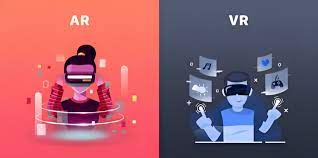In the rapidly evolving landscape of technology, two groundbreaking concepts have emerged as transformative forces – Virtual Reality (VR) and Augmented Reality (AR). These immersive technologies have transcended the realm of science fiction, capturing the imagination of tech enthusiasts, businesses, and consumers alike. In this article, we’ll delve into the intricacies of VR and AR, exploring their applications, differences, and the exciting possibilities they bring to various industries.
Table of Contents
Understanding Virtual Reality (VR):
Virtual Reality is a technology that immerses users in a simulated, computer-generated environment, isolating them from the physical world. VR typically involves the use of a head-mounted display (HMD) that covers the user’s eyes and ears, providing a fully immersive experience. The primary objective of VR is to create a sense of presence, making users feel as though they are truly existing within the virtual space.
Applications of Virtual Reality:
- Gaming and Entertainment: VR has revolutionized the gaming industry by transporting players into lifelike virtual worlds. From breathtaking landscapes to heart-pounding adventures, VR gaming offers an unprecedented level of immersion.
- Education and Training: In the realm of education, VR enables students to explore historical events, scientific phenomena, and complex concepts in a realistic, interactive environment. It also plays a crucial role in training simulations for various professions, such as aviation, healthcare, and military training.
- Healthcare: VR is making significant strides in healthcare, providing therapeutic solutions for pain management, exposure therapy, and even surgical training. Virtual reality experiences can aid in rehabilitation and enhance the overall patient experience.
- Real Estate: Virtual reality allows potential homebuyers to take virtual tours of properties from the comfort of their homes. This technology is revolutionizing the real estate industry by providing a more immersive and convenient way to explore homes.
Decoding Augmented Reality (AR):
While Virtual Reality immerses users in a digital environment, Augmented Reality overlays digital information onto the real world. AR enhances the user’s perception of reality by blending virtual elements with the physical environment. Unlike VR, AR does not require isolation from the real world, making it a more seamless integration of digital and physical experiences.
Applications of Augmented Reality:
- Mobile Apps: AR has found widespread use in mobile applications, enriching experiences in gaming (think Pokémon Go), social media filters, and navigation apps. It enhances everyday activities by adding digital layers to the real world through smartphone cameras.
- Retail and Shopping: In the retail sector, AR is transforming the way customers shop. AR apps enable users to visualize furniture in their homes before making a purchase, try on virtual clothing, and even see how cosmetics look on their faces.
- Education: AR enhances learning by bringing textbooks and educational materials to life. Students can use AR apps to access additional information, interactive 3D models, and engaging multimedia content related to their studies.
- Manufacturing and Maintenance: AR aids workers in manufacturing and maintenance tasks by providing real-time information and guidance. It overlays digital instructions onto physical objects, facilitating complex assembly processes and equipment maintenance.
Differences Between VR and AR:
While both VR and AR offer immersive experiences, they differ in their approaches and applications. VR creates a fully immersive, computer-generated environment, whereas AR enhances the real world by overlaying digital information.
- Interaction with the Environment:
- VR: Users are fully immersed and isolated from the real world.
- AR: Users interact with the real world while digital information is overlaid onto their surroundings.
- Hardware Requirements:
- VR: Typically requires a dedicated headset (HMD) and controllers.
- AR: Can be experienced through various devices, including smartphones, smart glasses, and AR glasses.
- Use Cases:
- VR: Predominantly used for gaming, simulations, and immersive experiences.
- AR: Applied in gaming, education, retail, manufacturing, and more, integrating digital elements into real-world scenarios.
The Future Outlook:
The convergence of VR and AR is paving the way for a mixed reality (MR) future, where the boundaries between the physical and digital worlds continue to blur. As technology advances, we can anticipate more seamless and integrated experiences that leverage the strengths of both VR and AR.
Industries are increasingly adopting these immersive technologies to enhance customer engagement, streamline processes, and offer innovative solutions. As hardware becomes more sophisticated and affordable, the accessibility of VR and AR experiences will likely grow, reaching broader audiences.
Conclusion
In conclusion, Virtual Reality and Augmented Reality represent a paradigm shift in how we interact with digital content and the world around us. From transforming gaming and entertainment to revolutionizing education, healthcare, and various industries, VR and AR are at the forefront of innovation. As these technologies continue to evolve, the possibilities are limitless, and the journey into the immersive realms of virtual and augmented reality is only just beginning.

